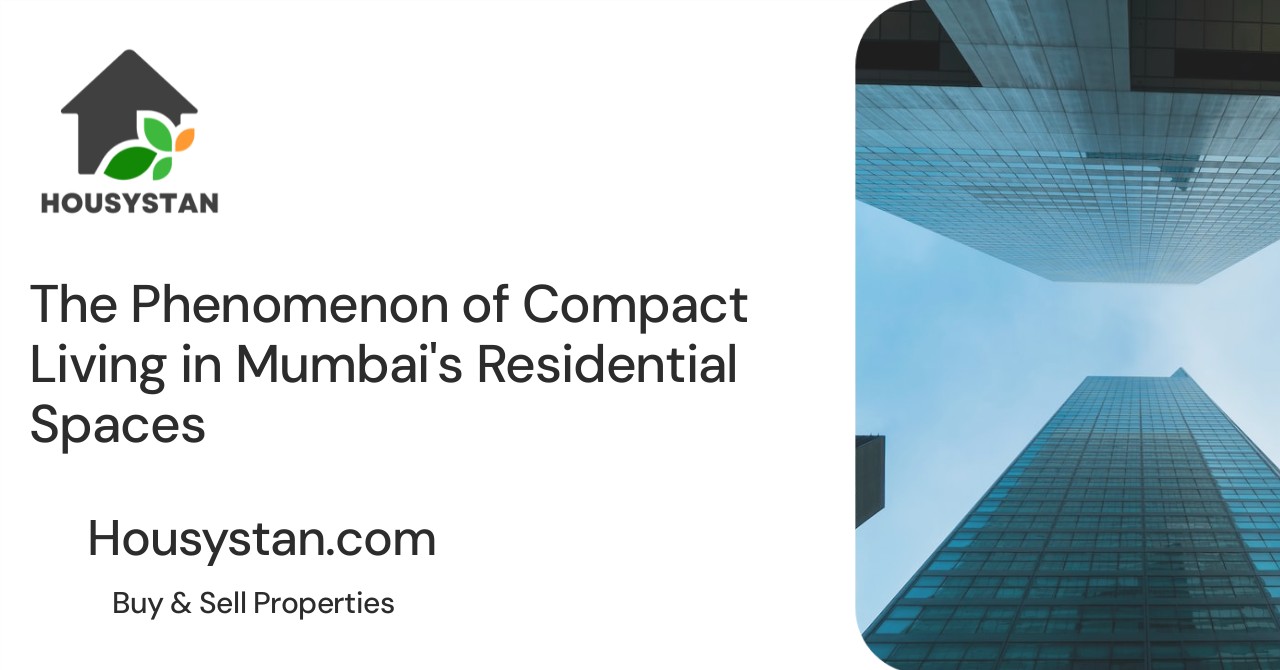The Phenomenon of Compact Living in Mumbai's Residential Spaces
Read latest blogs and articles from Housystan

The Information mentioned here was last updated on:
27/11/2025The Phenomenon of Compact Living in Mumbai's Residential Spaces
Mumbai, renowned for its vitality and dynamism, is often referred to as the city that never sleeps. With its soaring skyscrapers and sprawling slums, Mumbai encapsulates contrasts like no other metropolis. One of the most unique aspects of life in Mumbai is its compact living phenomenon, where millions find ways to make small spaces work in harmony with their daily lives.
What is Compact Living?
- Verified Tenants/Buyers
- Unlimited Property Listing
- Zero subscription/charges fee
Compact living refers to the ingenious use of limited space, transforming small areas into fully functioning environments. As the population of major urban centers swells, particularly in a city like Mumbai, the need for efficient housing solutions becomes paramount. This urban lifestyle trend involves maximizing functionality and aesthetics while embracing minimalist principles.
The Rise of Compact Living in Mumbai
Mumbai's landscape is characterized by its dense population, limited land, and escalating real estate prices. These factors have converged to make compact living not just a choice, but a necessity. The demand for property far exceeds supply, causing a surge in prices that compels many residents to opt for smaller homes.
Some key factors contributing to the rise of compact living include:
- High Real Estate Costs: The cost per square foot in Mumbai is among the highest in India.
- Population Density: Nearly 20 million people in an area of 603 square kilometers results in severe space constraints.
- Urban Migration: As more people move to Mumbai for employment opportunities, the pressure on housing increases.
Innovative Solutions for Small Spaces
Compact living isn’t merely about fitting into small spaces but making those spaces work efficiently. Here's how residents and designers are turning constraints into creativity:
1. Multifunctional Furniture: Designed for versatility, these pieces include sofa beds, extendable dining tables, and wall-mounted desks.
2. Smart Storage Solutions: Vertical storage systems, under-bed drawers, and built-in shelving units help maximize every inch.
3. Open Floor Plans: Removing unnecessary walls and partitions to increase the sense of space.
4. Use of Mirrors: Mirrors expand visuals, creating an illusion of space.
5. Natural Light: Large windows and skylights bring in light, making rooms feel bigger and more inviting.
6. Minimalist Design: Emphasizing simplicity and decluttering to enhance fluidity and comfort.
Living Big in Small Spaces
Living in a compact space doesn't mean compromising on quality of life. Here are some benefits of compact living in Mumbai:
- Efficiency: Less space means less time spent cleaning and organizing.
- Sustainability: Smaller homes consume less energy, leaving a smaller carbon footprint.
- Community Living: Shared spaces in apartment complexes foster a sense of community and interaction.
- Cost Savings: Lower maintenance, utility costs, and property taxes.
To further explore your living options in Mumbai, consider checking out local real estate websites or community forums.
Challenges of Compact Living
Despite its advantages, compact living also presents several challenges:
- Limited Privacy: Small spaces can lead to cramped quarters, affecting personal space.
- Customization Constraints: There is less room for personalization and decorating.
- Storage Issues: Accumulating belongings is more challenging with limited space.
- Adjustment Period: Those used to larger homes may find the transition difficult initially.
Social Impacts and Trends
Beyond individual adjustments, compact living has broader social implications that reflect in urban planning and housing policies:
- Cultural Shift: Acceptance of compact living reflects changing attitudes towards consumption and materialism.
- Innovation Drive: Encourages innovation in architecture and interior design.
- Policy Influence: Drives government initiatives on affordable housing and urban development.
Future of Compact Living in Mumbai
As Mumbai continues its journey of vertical urbanization, the concept of compact living will evolve. Future trends could involve:
- Micro-Apartments: Even smaller units efficiently designed for maximum functionality.
- Co-Living Spaces: A blend between private and shared spaces, encouraging community living.
- Technological Integration: Smart home technology making compact living more convenient and efficient.
- Sustainable Materials: Environmentally friendly options becoming mainstream in construction.
Adapting to Compact Living: Tips and Tricks
For those considering the transition to compact living, here are some practical tips:
1. Prioritize Essentials: Focus on what you truly need and let go of excess.
2. Stay Organized: Regularly declutter to maintain a serene environment.
3. Be Creative: Use colors, textures, and decorations to add personality without overcrowding.
4. Invest Wisely: Choose quality over quantity for long-lasting and multifunctional furnishings.
5. Leverage Technology: Utilize apps and tools for organization and design inspiration.
Mumbai's compact living spaces embody resilience and adaptability. These spaces not only accommodate the city's bustling population but also capture the essence of a fast-paced urban lifestyle. Through smart design, effective planning, and a community-focused approach, compact living in Mumbai offers a blueprint for sustainable urban life.
For more information on living trends in Mumbai's residential spaces or to explore housing options, consider visiting local realtor websites or urban planning resources.